DALI (Danish Audiophile Loudspeaker Industries) lives up to its name by making superb-sounding speakers, including the recently reviewed Rubicon 6. The company has also dipped its toes into the wireless-headphone pool with the IO-4 and IO-6, which I love for its rich, sumptuous sound.
So, it’s hardly surprising that DALI would venture into the realm of soundbars. The Katch One is based on the company’s Katch Bluetooth speaker, which I will be reviewing soon. Meanwhile, I got to spend some time with the Katch One, and under the right circumstances, it sounds excellent.
This review is part of TechHive’s coverage of the best soundbars, where you’ll find reviews of competing products, plus a buyer’s guide to the features you should consider when shopping.
Features
Available in three colors to match a variety of décors, the Katch One is a slender but very tall soundbar, requiring much more room than most beneath a TV. Measuring 33.9 x 6.5 x 2.7 inches (WxHxD) and weighing a total of 8.2 pounds, the cabinet and front baffle are molded from fiberglass-reinforced ABS, which forms a highly rigid structure that resists resonances as the drivers vibrate.
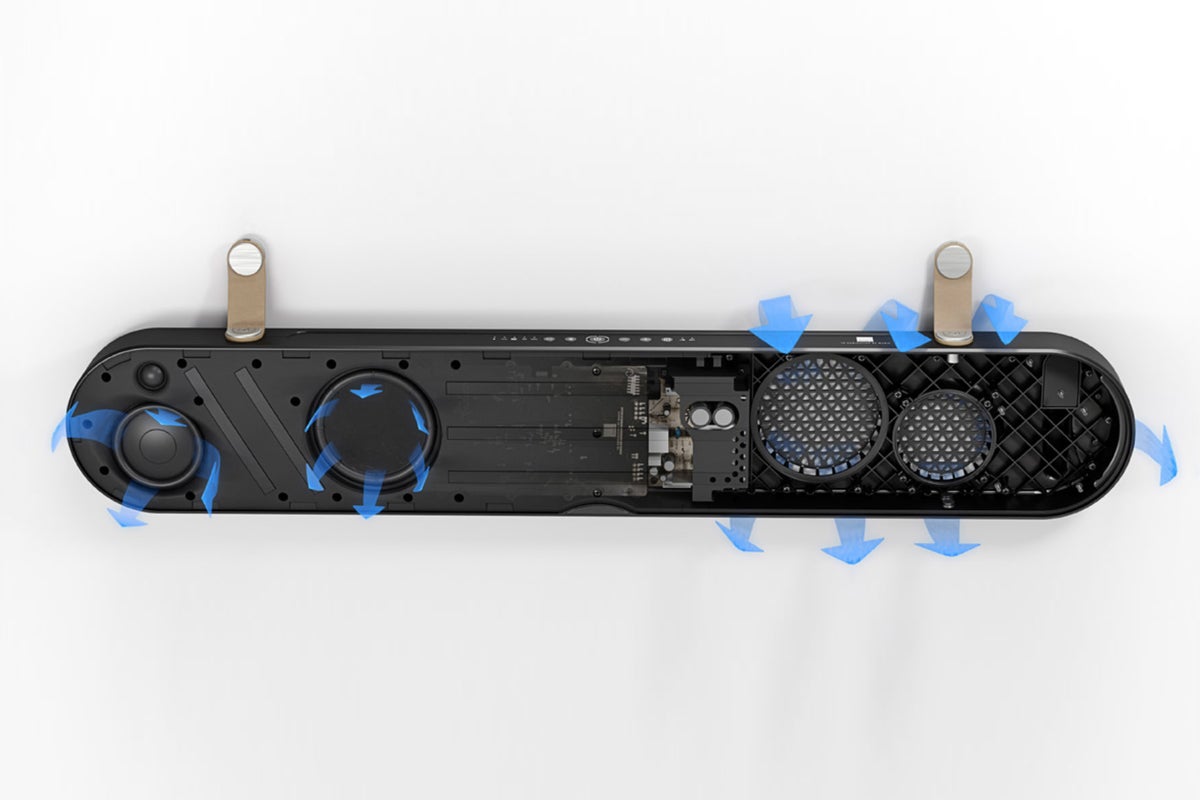 DALI
DALI
The cabinet is designed so sound from both the front- and rear-firing drivers flows toward the listener.
Speaking of the drivers, they include two 0.8-inch soft-textile dome tweeters with neodymium magnets and four 3.5-inch aluminum-cone woofers with a textile cap. In addition, there are four 4.5-inch steel-cone passive radiators in the bass-reflex system. The shallow woofers are said to allow the full excursion of a conventional woofer by using a specially designed chassis, inverted diaphragm, and custom spider suspension.
Two woofers and two radiators face forward with the tweeters, while the other two woofers and radiators face backward. This design is intended to reinforce the low frequencies with the soundbar mounted on or near a wall. The Katch One comes with short leather straps for wall mounting, or you can use the more conventional brackets on the back. Alternatively, the included feet let it stand freely on a surface.
The drivers are powered by four 50W Class D amplifiers with a signal-to-noise ratio of 100dB. A powerful DSP provides an active crossover and operates internally at a resolution of 24 bits/96 kHz, though the unit can accept inputs up to 24/192 (which are downconverted to 24/96). According to DALI, “The surplus of computing power lets the DSP step in before the amplifier or the drivers get over extended, and at the same time giving it the ability to go completely hands-off, allowing the drivers to deliver a coherent and undistorted audio signal.” Altogether, the drivers, amp, and DSP support a frequency response from 46Hz to 25kHz (±3 dB) and a maximum output of 101dB SPL.
In addition, the DSP provides two sound modes: Focus and Wide. Focus mode delivers a focused stereo signal, while Wide mode is said to expand the sound beyond the physical dimensions of the cabinet.
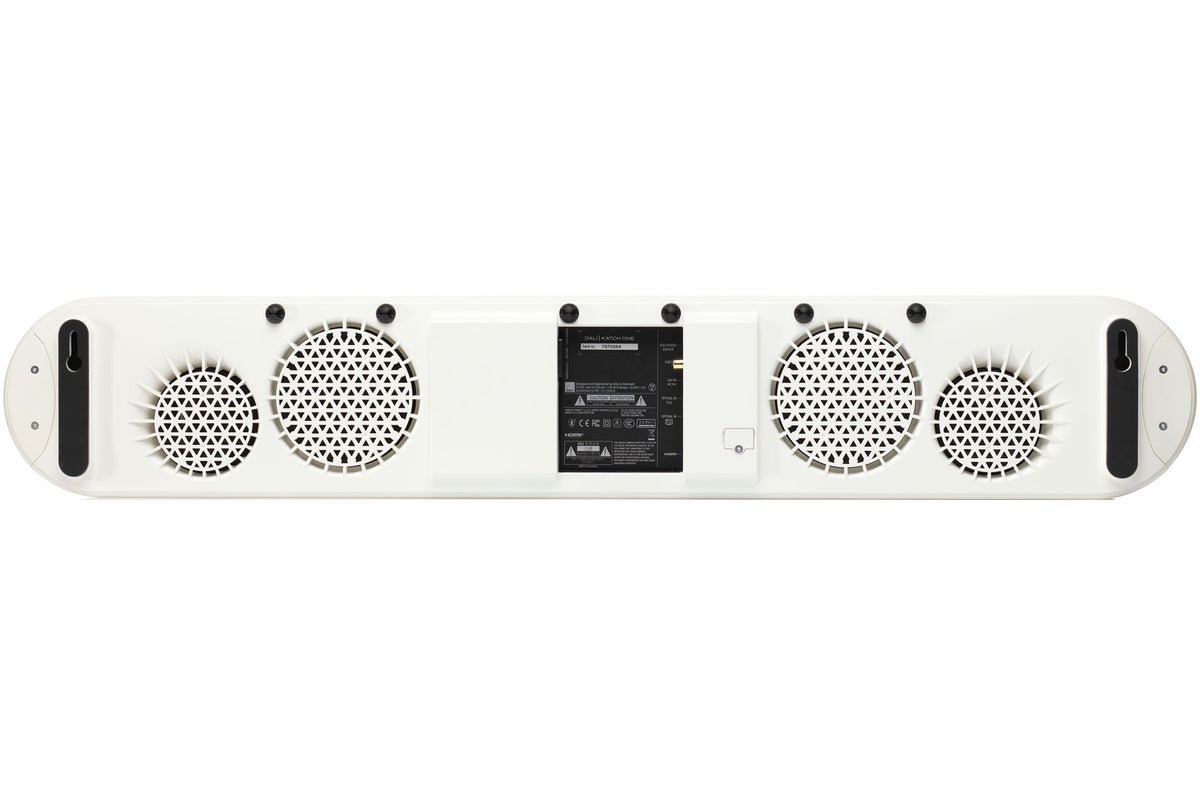 DALI
DALI
The back of the DALI Katch houses two 3.5-inch active woofers and two 4.5-inch passive radiators.
Connections include one HDMI input, which normally connects to a TV’s HDMI ARC input while source devices like a streaming box, disc player, and/or game console are connected to the TV’s other HDMI inputs. As you may know, ARC stands for Audio Return Channel, which sends audio from that input back along the cable that normally brings audio and video signals to the TV from something like an AV receiver. In that case, audio from the TV’s built-in apps and over-the-air tuner are sent back to the AVR along the same cable.
With the Katch One, however, the TV’s HDMI ARC input acts like an audio output, sending audio to the soundbar from the other HDMI inputs as well as the TV’s internal apps and tuner. Unfortunately, that means the TV’s ARC input can’t be used for a source device, and in some cases, the ARC input is the TV’s highest-bandwidth HDMI input. Also, it’s possible that some TVs might not route the audio from other HDMI inputs to the ARC output. It’s also worth noting that the Katch One doesn’t support the higher-bandwidth version of ARC—eARC—found on the latest-model smart TVs (click here for a deeper exploration of the two standards).
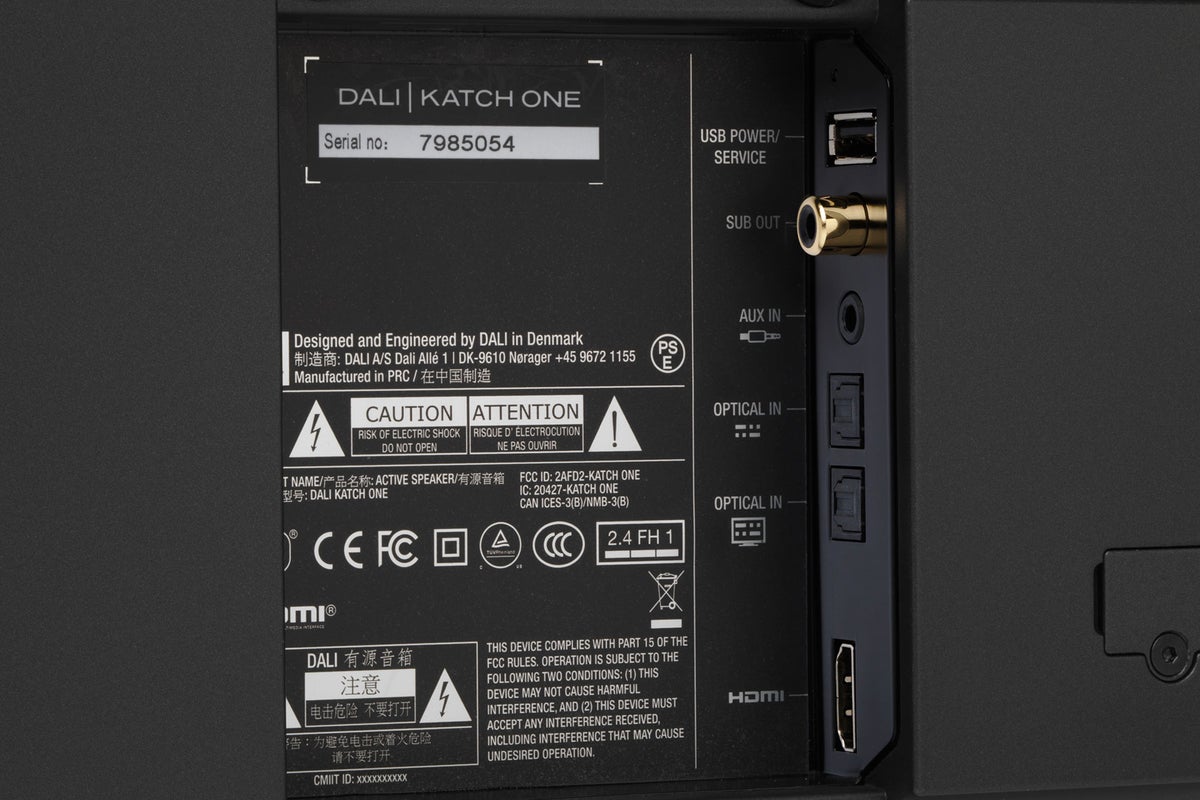 Scott Wilkinson / IDG
Scott Wilkinson / IDG
The connections include (top to bottom) USB-C for power and service, subwoofer output, 3.5mm aux input, optical input, TV optical input, and HDMI input.
If your TV has an ARC input, its audio output must be set to stereo or PCM, since the Katch One doesn’t provide a Dolby Digital or DTS decoder. Also, if the TV offers CEC (Consumer Electronics Control), you can control the basic functions of the Katch One (volume, mute, power on/off) with the TV’s remote.
Other connections include two Toslink optical digital-audio inputs, one labeled TV and the other labeled simply Optical. What’s the difference? The TV optical input automatically powers on the soundbar and selects that input when it receives any light, while the other one powers up and selects the input only when it receives an optical audio signal. Apparently, some CD players and streamers leave the optical carrier on, even when there’s no signal, while TVs only send the carrier when they send a signal.
Rounding out the physical connections is a 3.5mm stereo analog input, a 3.5mm subwoofer output that connects to an optional sub, and a USB-C port that’s mainly used for firmware upgrades. It can also be used to power a Google Chromecast or Amazon Echo device, adding voice control and support for TuneIn and Spotify as well as other streaming services.
The Katch One also supports Bluetooth 4.0 using the AAC and aptX codecs. This can be used to connect to a Bluetooth-enabled mobile device or TV.
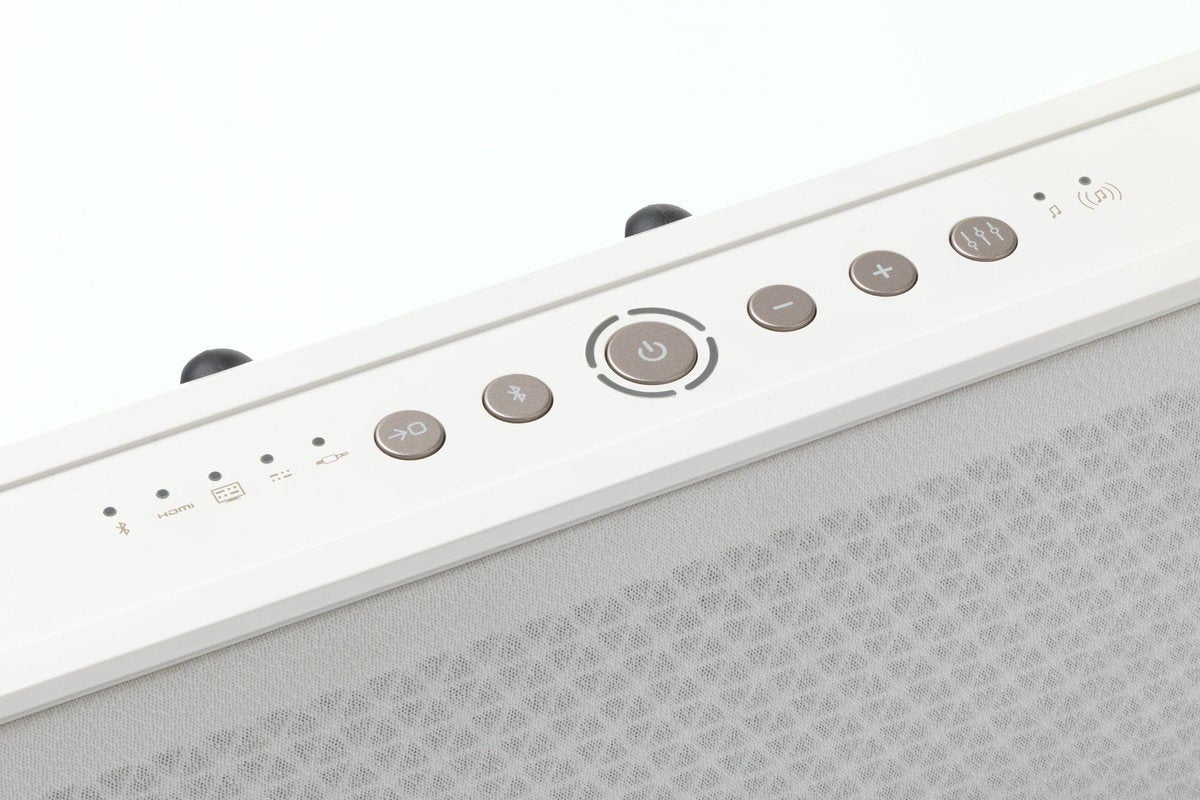 DALI
DALI
The top-mounted controls and indicators provide complete control, but they can’t be easily seen from a normal listening position.
User interface
The top of the Katch One houses all onboard controls and indicators. The central power on/off button is ringed by four quarter-circle LEDs that indicate the volume level, which is controlled with the “+” and “-“ buttons to the right. The next button toggles between the Focus and Wide sound modes, which are indicated with two LEDs. To the left of the power button are a Bluetooth pairing button and a source-select button that cycles through the inputs, each of which has its own LED indicator.
As I mentioned earlier, the Katch One automatically powers on and selects the input that receives a signal at either of the optical inputs. But it also does the same thing when any of the inputs, including Bluetooth, receives an active signal. You can disable this function if you wish.
The included remote is quite simple; it has only 10 buttons. At the top are power on/off, mute, and sound-mode select, below which are volume up and down. The five remaining buttons directly select any of the inputs. The Bluetooth button serves double duty as a transport control, letting you play/pause and skip to the next or previous track. The buttons are flush with the casing with no separation or tactile differentiators, making them difficult to find by feel.
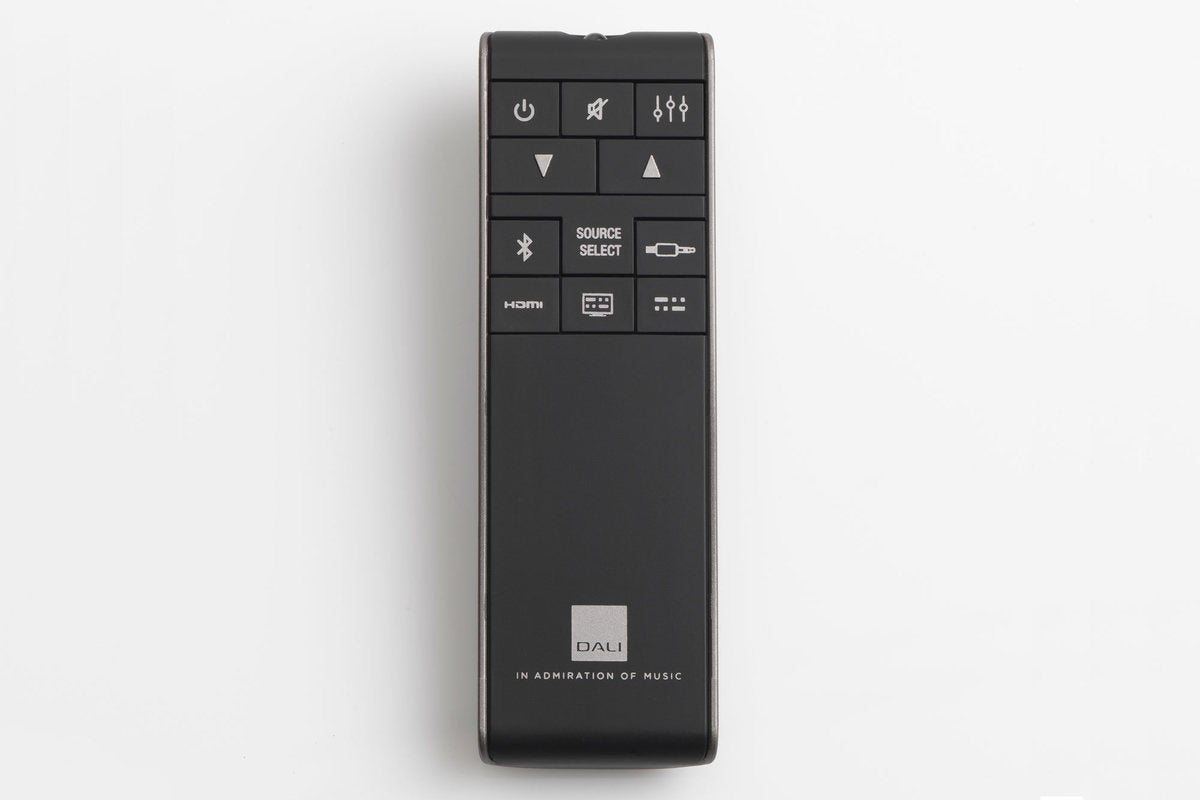 DALI
DALI
DALI’s remote is super simple, but the buttons are difficult to find by feel.
The user interface has one major shortcoming: The only way to see the status of the soundbar is on the top, which is more or less invisible from a typical listening position. Many soundbars have an alphanumeric display that momentarily displays the volume, input, and other info through the front grille, but the Katch One doesn’t have that particular feature. I found myself wishing for it many times.
Performance
I started by placing the Katch One on a stand below and in front of my bedroom TV and connecting the TV’s optical-audio output to the soundbar’s TV optical input. As promised, when I turned on the TV, the soundbar powered on and switched to that input.
TV audio sounded fairly clean, open, and bright, but there wasn’t much bass. I suspect that’s because there was no place to put the Katch One up against a wall, which is the placement it’s designed for. In my room, it was up against an equipment cabinet with glass doors, but one of the doors is missing, so there was no continuously solid surface immediately behind it.
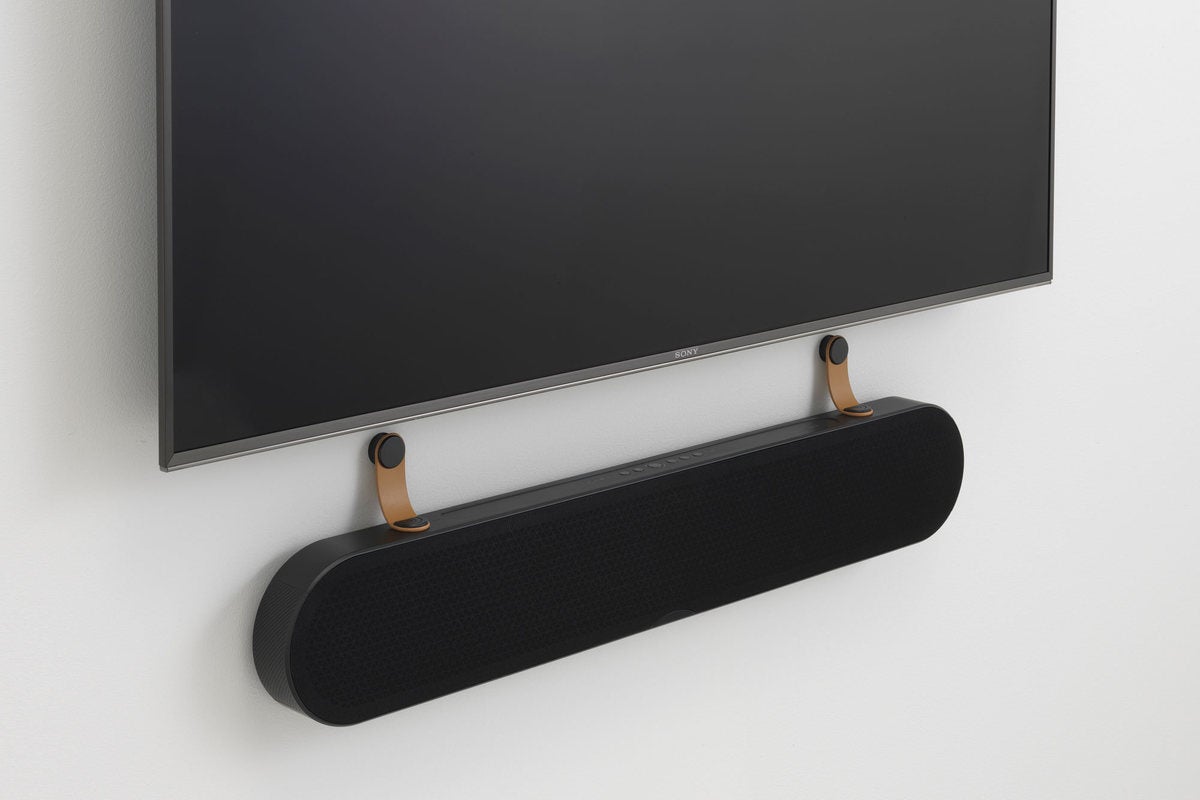 DALI
DALI
One unique wall-mounting option is a pair of included leather straps.
For my formal listening, I played music from the Tidal Master library from my iPhone XS via Bluetooth. From its location on the stand in front of the TV, the sound was pretty wimpy, so I tried placing it on top of the Harman Kardon Enchant 800 soundbar that sits much closer to the TV. That put the Katch One directly in front of the TV screen, which greatly improved its sound quality. But the soundbar also blocked a quarter of the TV screen, so I could not use it in this position to watch TV.
I began with “What Happened to Our Love?” from country rocker Margo Price’s new album That’s How Rumors Get Started. As I switched back and forth between Focus and Wide mode, I noticed that the soundstage was definitely confined to the cabinet in Focus mode, and the sound was somewhat thin with anemic bass, but the vocals were quite pronounced. Switching to Wide mode, the sound opened up significantly with more bass, though the vocals receded a bit. The soundstage was slightly wider, but not dramatically so. Still, Wide mode sounded much better than Focus, so I used it for the rest of my listening.
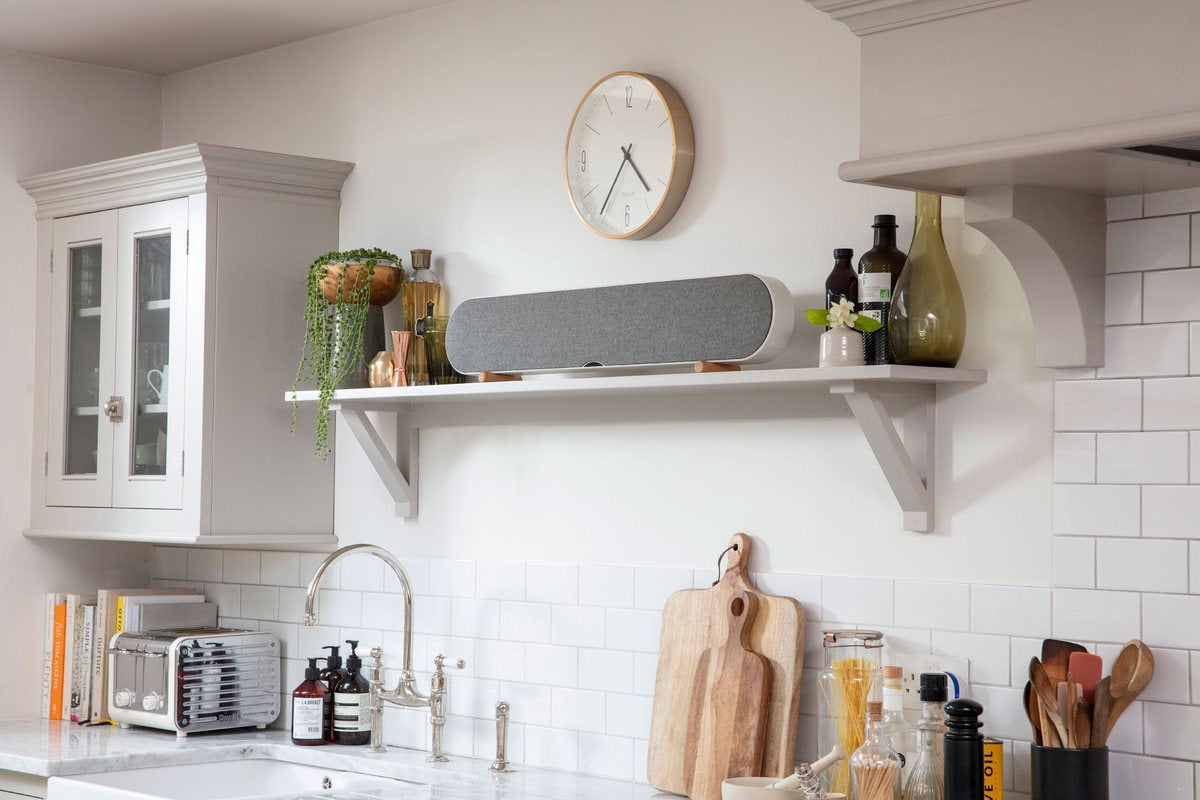 DALI
DALI
This soundbar can also be used as a Bluetooth speaker without a TV.
As a side note, I tried both modes while watching TV, and I could hear no difference between them at all. Perhaps that’s because the soundbar was freestanding and not up against a wall.
Next up was “Pili Pili” by Polo and Pan from their album Feel Good. This electronic world-music instrumental track sounded nice and clean on the Katch One with good imaging and bass as well as excellent delineation between sections with little and lots of reverb. Overall, the sound was a bit bright.
For some funk and R&B, I cued up “Right Place Wrong Time” as recorded by Maceo Parker for his album Soul Food: Cooking with Maceo. Wide mode was very effective on this track, casting a soundstage that was much wider than the cabinet. The overall sound was clean and bright with great imaging, good vocals, and moderate bass presence.
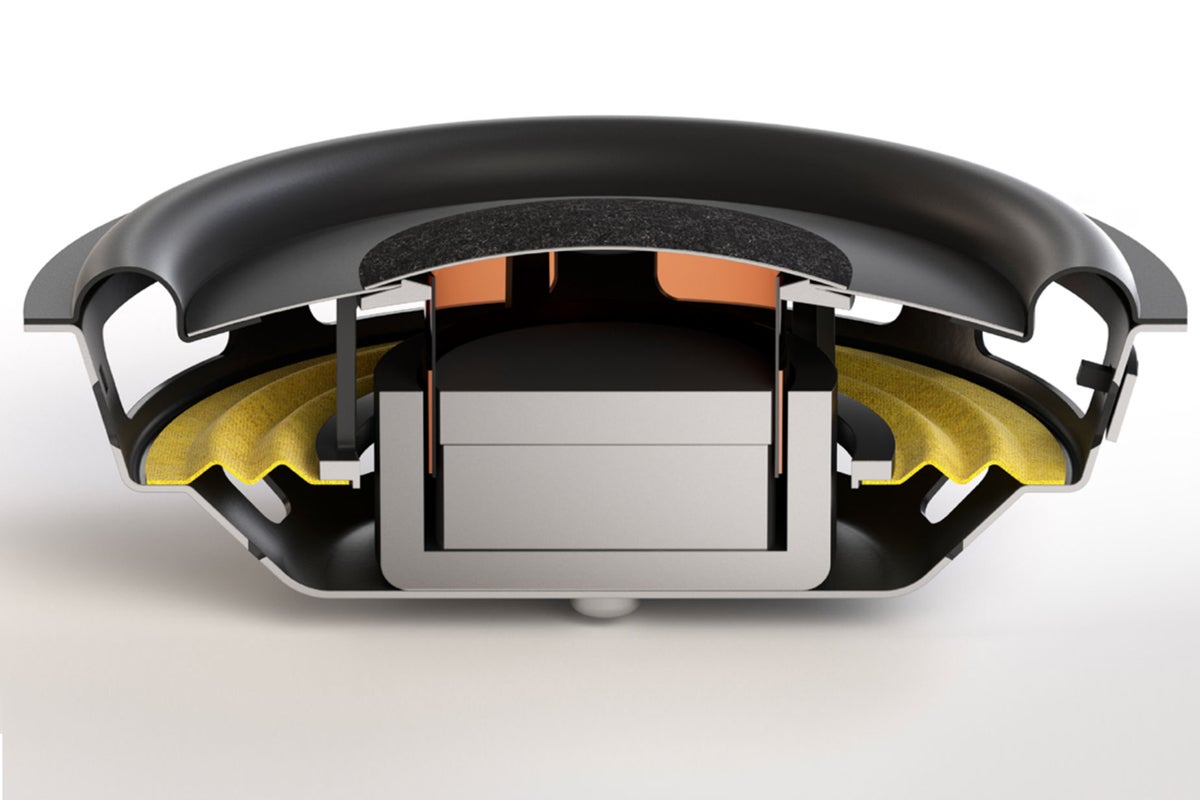 DALI
DALI
The shallow woofer’s design allows the same excursion as a conventional woofer.
I love jazz bassist and composer Misha Mullov-Abbado’s album Dream Circus, so I listened to the track “Little Vision” for this review. The Katch One sounded clean and well-balanced with a great rendition of the acoustic bass, alto sax, and piano. As before, the overall sound tended slightly toward the bright side.
Moving on to classical, I played the third movement of Stravinsky’s Symphony of Psalms as performed by the San Francisco Symphony under the direction of Michael Tilson Thomas. As I had come to expect, the Katch One had an open, clean, somewhat bright sound with well-rendered choir and orchestra and good low organ notes.
Comparison with Harman Kardon Enchant 800
As I mentioned earlier, I had the Harman Kardon Enchant 800 soundbar on hand (reviewed here), and I started by using it as a stand for the Katch One. I also compared the sound of the two soundbars, switching between them via Bluetooth from within Tidal. I couldn’t really compare them for TV sound, since the Katch One was blocking some of the screen, and swapping optical cables is pretty clumsy.
In all cases, the Enchant 800 sounded somewhat darker and a bit closed in, though it was often smoother as well. On a few tracks, the bass was slightly congested, especially acoustic bass. Interestingly, the bass was a bit more forward on the Stravinsky. But these differences were relatively minor overall.
Bottom line
There’s a lot to like about the DALI Katch One—but only under certain circumstances. It’s much taller than most soundbars, so you must have plenty of room below the TV for it. And it must be placed up against a wall or other large, flat surface to sound its best; it sounds pretty wimpy when freestanding away from the wall.
With the right placement, its sound is clean, open, and well balanced, though it’s a tad on the bright side. By comparison, the Harman Kardon Enchant 800 sounds darker overall and slightly closed in. On the other hand, the Harman Kardon is very slender, allowing it to easily fit below most TVs, and it has an alphanumeric display behind the front grille cloth that momentarily reveals any status changes such as volume.
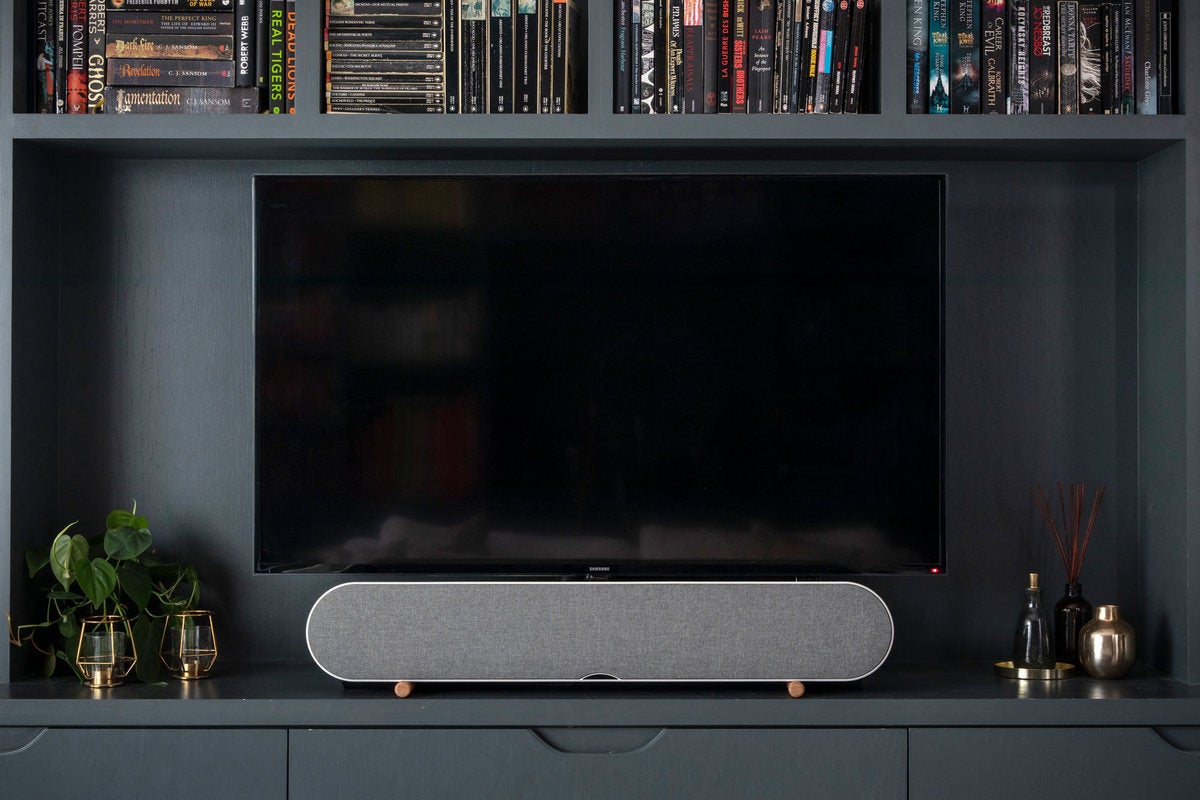 DALI
DALI
The DALI Katch One’s tall profile might block the bottom of your TV’s screen if it rests in front on a piece of furniture (unless you put your TV on a riser).
Then there’s the price tag. The Katch One lists for $999, while the Enchant 800’s MSRP is just under $700, but as of this writing, it’s on sale for $280 on Amazon and elsewhere. And of course, there are many good soundbars on the market that cost a fraction of $1,000, some of which even include a wireless subwoofer (including the LG SN8YG reviewed here earlier this week).
If you have enough wall space below your TV and you enjoy elegant Danish design, the DALI Katch One is an excellent soundbar. It can also be used as a Bluetooth speaker without a TV. On the other hand, it’s very expensive, and there are many such products that perform very well for a lot less. Plus, most of them do not require a lot of space beneath the TV, nor do they need to be placed up against a wall to sound their best. Whether or not the Katch One is right for you depends on your circumstances, so the decision is yours.
"sound" - Google News
July 17, 2020 at 05:00PM
https://ift.tt/2OzKzhH
DALI Katch One soundbar review: Great sound—under the right circumstances - TechHive
"sound" - Google News
https://ift.tt/2MmdHZm
Shoes Man Tutorial
Pos News Update
Meme Update
Korean Entertainment News
Japan News Update

No comments:
Post a Comment